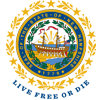Invasive Species
To address mounting concerns over invasive plants and the role NHDOT activities play in the spread of these plants along roadsides, Best Management Practices (BMPs) have been developed with input from Maintenance Districts, the Roadside Development Section, the Bureau of Construction, and the NH Department of Agriculture.
Best Management Practices
Implementation of these BMPs will help prevent the spread of invasive plants caused by maintenance and construction activities.
Biological Control of Purple Loosestrife
In 1997, the NH Department of Transportation’s (NHDOT) Bureau of Environment and the NH Department of Agriculture, Markets & Food (NHDAMF), Division of Plant Industry, worked together to establish a cooperative effort for the management of purple loosestrife (Lythrum salicaria) populations in New Hampshire. The project was developed in accordance with the US Department of Agriculture’s Animal Plants Health Inspection Service (USDA-APHIS) Multi-State Purple Loosestrife Project. A pilot study grant, in the amount of $30,000, was awarded by the NHDOT’s State Planning and Research (SPR) program to develop the project. Sites were selected, transects were established, and biological control agents were acquired.
As of 2004, this project has resulted in approximately 217,000 beetles being purchased for release into purple loosestrife invaded wetlands throughout the State. With the help of the community project and those sites managed by the NHDOT, all ten counties in the state are being managed with Galerucella beetles to some degree. The majority of the releases have occurred in towns in the central and southeastern portions of the state, mainly as a result of the high density of purple loosestrife occurring in these areas.
Seaplanes vs. Milfoil and Other Invasive Aquatic Plants
We've all seen the announcements of invasive aquatic plant species in some of NH's inland waters (namely milfoil) and to be careful so as not to transfer plants or plant parts from one waterbody to the next. Most seaplane pilots already know that the milfoil issue is not just a boat issue but also a seaplane issue. While it's a little easier to manage the spread of these plants from boats, the job is more difficult for seaplanes that may take off from one lake and land at another one and yet another one. Keeping NH's inland waters in good shape is a responsibility we all share. The Seaplane Pilots Association (www.seaplanes.org) holds safety seminars at which they've distributed free CDs with best practices seaplane pilots can use for not transferring invasive aquatic species from one waterbody to another. Mr. Mark "Woody" Woodruff is the NH Field Director for the Seaplane Pilots Association and can be reached at presidentialseaplanes@gmail.com for more information.
Cooperative Weed Management Areas
A Cooperative Weed Management Area (CWMA) is a partnership of federal, state, and local government agencies; individuals; and various interested groups that pool resources, set priorities, and manage invasive plants in a defined area. CWMAs are more prevalent in the western United States, but are becoming more common in the east.
One CWMA in the State is the NH Coastal Watershed Invasive Plant Partnership. The NHDOT is a signatory to this partnership.
- Marc Laurin - Senior Environmental Manager, Marc.Laurin@dot.nh.gov
Galerucella pusilla
Purple Loosestrife leaf-feeding beetles,
Galerucella pusilla and G. calmariensis




